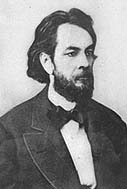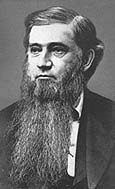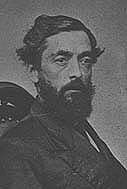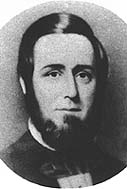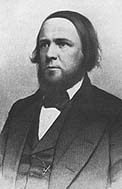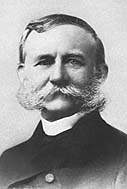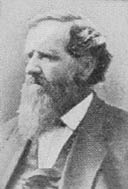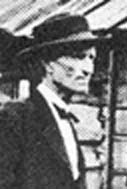| Angier, J.D. |
| Bissell, George H. |
| Brewer, Francis B. |
| Crosby, Albert H. |
| Drake, Edwin L. |
| Eveleth, Jonathan G. |
| Fletcher, R.D. |
| Hubbard, O.P. |
| Kier, Samuel |
| Mackeown, W. |
| Sheldon, Anson |
| Silliman, Benjamin Jr. |
| Smith, William A. |
| Townsend, James M. |
| Watson, Jonathan |
| Wilson, Peter |
|
| |
| |
|
Joel D. Angier
|
|
Under Brewer's urging, Brewer, Watson and Company in 1853 leased the seep and rights to gather oil for five years to Angier who gave it a good try. He irrigated the seep area and made a collection basin. A few gallons per day in season were all that could be counted on. This was the first working oil lease. Angier later became the first mayor of Titusville, 1866.
|
 |
|
| |
| |
|
|
|
George H. Bissell
|
|
Dartmouth graduate. Junior partner of the New York law firm of Eveleth and Bissell. A prime mover in the organization of the first petroleum companies. Deeply interested in oil from the Titusville seep, he conceived the idea of drilling for oil in the manner of the salt borings. After Drake's strike, Bissell leased oil rights on many farms in the fledgling oil region, even seasonal gravel bars in Oil Creek. Sometimes he bought the properties. He was alert, nimble and scrambled to make money in oil. He was also influential in the rail transportation of oil.
|
 |
|
|
|
| |
| |
 |
|
Francis B. Brewer
|
|
Dartmouth College graduate (in medicine). Arrived at Titusville in 1851 and joined the lumber firm of Brewer, Watson and Company. He became very interested in the seep on the company's property there. In 1853, a little bottle of crude oil which he carried to Hanover, New Hampshire, was seen by professors visiting Hanover from Dartmouth. They thought it might be valuable. This bottle of seep oil later attracted favorable attention on the part of other Dartmouth people including the lawyer George H. Bissell. It was a sample which was seen at the right time by the right people. Brewer's considerable reputation, his contacts in New England plus being a principal on the scene at the Titusville seep, allowed him to be a very strong player in the promotion of oil.
|
| |
|
|
|
| |
|
Albert H. Crosby
|
|
Bissell saw a bottle of seep oil in Dr. Dixi Crosby's office in Hanover, New Hampshire. The doctor's son, Albert H. Crosby seized upon the occasion to get Bissell to finance an inspection trip to Titusville. While there he received a proposal from Dr. Brewer for purchase of the Hibbard farm on Oil Creek, including the seep near the Upper Mill. Albert Crosby promoted this proposal and it was later accepted by Eveleth and Bissell. Crosby did not remain financially steadfast and was bought out of the fledgling oil group. However, his enthusiasm for oil and its possible uses, served to importantly spread the optimism that carried on through the formative process of the first oil company.
|
 |
|
| |
| |
|
|
|
Edwin L. Drake
|
|
Became first President (briefly) and a stock holder of the Seneca Oil Company, successor to the rock oil companies organized in New York and Connecticut. By prior agreement he was appointed General Agent of the Seneca Oil Company in charge of operations in Titusville. His determination and ingenuity saw the pioneer oil well undergo a successful completion.
|
 |
|
|
|
| |
| |
|
Jonathan G. Eveleth
|
|
New York lawyer and businessman. Sage, cautious and tenacious. Worked hard on the formation of the first oil company and led it through the formative years. He and Bissell contracted the services of Benjamin Silliman Jr. to analyze the seep oil. Eveleth was the principal promoter of the Pennsylvania Rock Oil Company of New York, later changed to New Haven, Connecticut. Eveleth's strong presence was essential in the pre-oil strike years. Many major decisions were his.
|
 |
|
| |
| |
|
Reuel Danforth Fletcher
|
|
On Eveleth's first visit to the seep in 1854, Fletcher, a clerk with Brewer, Watson & Company, drove Eveleth to the seep and helped him to inspect it. The result was great enthusiasm on the part of Eveleth (sometimes it pays to be the chauffer). Fletcher became a Titusville merchant and helped Drake by extending credit for personal supplies and later helping him to secure loans.
|
 |
|
| |
| |
|
O.P. Hubbard
|
|
O.P. Hubbard was a professor of chemistry at Dartmouth College. Hubbard and Dr. Dixi Crosby of the Dartmouth Medical School examined a sample of seep oil procured by Dr. Brewer of Titusville in 1853. Hubbard said that the oil was valuable and lamented that it couldn't be obtained in large quantities. The words of these two professors regarding crude oil helped to set the early stage for investigation of oil deposits in the Titusvillle area.
|
 |
|
| |
| |
|
|
|
Samuel Kier
|
|
First distillation of petroleum from seeps and salt wells into illuminating oil at Pittsburgh, about 1850. Days after it was struck, Kier bought oil from the Drake Well in September, 1859, for 60 cents per gallon, delivered.
|
 |
|
|
|
| |
| |
|
W. Mackeown
|
|
Pittsburgh oil refiner who got a deal with Drake like Kier's. Mackeown and Kier were the first buyers of magnitude of Drake Well oil. The close of 1859 saw over $8800 of oil from this well purchased by these two refiners.
|
 |
|
| |
| |
|
Anson Sheldon
|
|
Prominent New Haven investor. Visited Titusville with Asahel Pierpont, acting for the New Haven shareholders. Pierpont had a strong mechanical background and was asked to look over the "machinery" that J.D. Angier was using to extract oil from the seep. They lent their names and observations to the veracity and potential of the oil seeps. Pierpont, via Sheldon, passed the message back to New Haven that the oil is there and that he was satisfied. This remark from a greatly respected and wealthy businessman, gave substance to the promotion in New Haven where both men were held in high regard.
|
 |
|
| |
| |
|
|
|
Benjamin Silliman Jr.
|
|
A Professor of Chemistry at Yale, he produced the most detailed and promising analysis of the seep oil. This document, used as promotional material, launched an industry. Silliman became a stock holder in the Pennsylvania Rock Oil Company of Connecticut and was elected President for a term. He later analyzed seep oil from California.
|
 |
|
|
|
| |
| |
|
|
|
William A. Smith
|
|
"Billy" Smith, a Tarentum, Pa., salt well driller and blacksmith (tool maker and dresser), accepted the job to drill Drake's well. He also had made tools for Samuel Kier and Peterson, both salt well operators. Smith was experienced in fishing, the word used to describe the process of retrieving a tool lost in the hole. He "threw in" the services of his young son, Samuel, as a part of the deal with Drake.
|
 |
|
|
|
| |
| |
|
|
|
James M. Townsend
|
|
President of the City Savings Bank in New Haven. A leader of the oil investors in Connecticut and major stock holder in the Pennsylvania Rock Oil Company of Connecticut which became Seneca Oil Company. He financed Drake's first trip to Titusville. His letters to Drake used the title "Colonel". His financial assistance from time to time enabled Drake to struggle on.
|
 |
|
|
|
| |
| |
|
|
|
Jonathon Watson
|
|
Wood boss and member of the Titusville lumber firm Brewer, Watson & Company. He helped Drake build his derrick. As soon as oil was struck, Watson leased as many farms as he could, especially on Oil Creek. He later became involved in drilling. His name is given to the area and oilfield where Drake's well is located: Watson's Flats. Drake's was the discovery well of that field, the first in the early oil belt.
|
 |
|
|
|
| |
| |
|
|
|
Peter Wilson
|
|
A Titusville druggist and friend of Drake. He is seen talking to Drake in one of the famous Mather photos of the Drake Well. Wilson (with Fletcher) co-signed a note in Meadville so that Drake could borrow $500.00, money desperately needed.
|
 |
|
|
|

